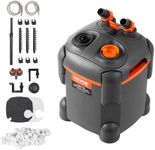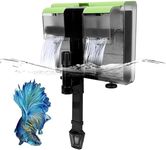Buying Guide for the Best Quiet Fish Tank Filter
Choosing a quiet fish tank filter is important for both the well-being of your aquatic pets and your own comfort, especially if the tank is in a living or sleeping area. A good filter keeps the water clean and healthy for your fish, but it should also operate quietly so it doesn't disturb you or the fish. When shopping for a filter, it's important to look at several key features to make sure you get the best fit for your tank size, fish type, and noise sensitivity.Noise LevelNoise level refers to how much sound the filter makes while running. This is especially important if your tank is in a quiet room or bedroom. Filters can range from nearly silent to noticeably loud. Generally, internal and sponge filters tend to be quieter, while some hang-on-back or canister filters can be louder, especially if not maintained well. If you are sensitive to noise or want a peaceful environment, look for filters that are specifically marketed as 'quiet' or 'silent,' and check user reviews for real-world feedback.
Filtration TypeFiltration type describes how the filter cleans the water. There are three main types: mechanical (removes debris), biological (breaks down waste using beneficial bacteria), and chemical (removes toxins and odors). Most filters offer a combination of these. For most home aquariums, a filter that provides all three types is ideal, but if you have a simple setup or sensitive fish, you might prioritize one type over the others. Think about the needs of your fish and the amount of waste they produce when choosing the right filtration type.
Tank Size CompatibilityTank size compatibility means the filter is designed to handle a certain volume of water, usually measured in gallons or liters. Using a filter that's too small for your tank can lead to dirty water and unhealthy fish, while an oversized filter might create too much current. Filters are usually labeled for the tank sizes they suit, such as 'up to 20 gallons.' Always match the filter to your tank size, and if your tank is heavily stocked, consider a filter rated for a slightly larger tank.
Flow RateFlow rate is the amount of water the filter moves per hour, often listed as GPH (gallons per hour) or LPH (liters per hour). A higher flow rate means more water is filtered, but too much flow can stress some fish, especially those that prefer calm water. For most tanks, a flow rate that cycles the entire tank volume 4-6 times per hour is a good rule of thumb. If you have delicate or slow-swimming fish, look for filters with adjustable flow rates so you can set it to a gentle level.
Ease of MaintenanceEase of maintenance refers to how simple it is to clean and care for the filter. A filter that is hard to take apart or clean can become noisy and less effective over time. Look for filters with easy-to-access parts and clear instructions. If you prefer low-maintenance options, sponge filters or filters with reusable media might be a good choice. Consider how often you are willing to perform maintenance when making your decision.
Installation TypeInstallation type describes how and where the filter is placed in or on the tank. Common types include internal (inside the tank), hang-on-back (attached to the tank rim), and canister (external, connected by hoses). Internal and sponge filters are usually quieter and easier to install, while canister filters are powerful but may require more setup. Choose the installation type that fits your tank space, your comfort with setup, and your noise preferences.

















